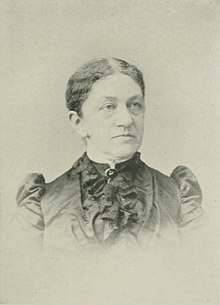Mary Galentine Fenner
Mary Galentine Fenner | |
|---|---|
 | |
| Born | Mary A. Galentine May 17, 1839 Rush, New York, U.S. |
| Died | July 10, 1903 (aged 64) Ovid, New York, U.S. |
| Resting place | Evergreen Lawn Cemetery, Akron, New York, U.S. |
| Occupation |
|
| Language | English |
| Nationality | American |
| Alma mater | Genesee Wesleyan Seminary |
| Spouse |
Francis Drake Fenner
(m. 1861; died 1894) |
Mary Galentine Fenner (née, Galentine; May 17, 1839 - July 10, 1903) was an American poet and litterateur.[1] She wrote for the Rural New Yorker before becoming a prolific versifier. She was also involved in the temperance and suffrage movements.[2]
Early life and education
Mary A. Galentine was born in Rush, New York, May 17, 1839.[1] Her grandparents were among the first settlers of the Genesee Valley and traced their lineage back to Hollanders.[3] Her father, John Galentine, was a native of Monroe County, then Ontario County, New York born 1803, was a leading man in Monroe County for many years, serving as Justice of Peace and Deputy Sheriff. In early life, he worked on a farm, but later helped to construct the Erie Canal. His wife was Isabel Stull, daughter of Jacob Stull, one of the earliest settlers of Western New York. Fenner had three siblings, Edwin J., Augusta Jane, and Jacob S.[4]
Fenner was educated in Genesee Wesleyan Seminary, Lima, New York. Among her school essays are several written in blank verse. She was graduated in 1861.[3]
Career
At a very early age, Fenner wrote for the Rural New Yorker. Her first published poem, "In Memoriam," dedicated to her mother on the anniversary of her father's death, in 1873, was written while she could not raise her head from her pillow. She subsequently became a prolific versifier, who published one volume of poems.[3]
Personal life
She married Rev. Francis Drake Fenner (1832-1894) on July 24, 1861,[5] one month after completing her studies at Genesee Wesleyan Seminary. They had three children, Leland, Anna, and Carl. Francis was a graduate of Rochester University and Rochester Theological Seminary (now Colgate Rochester Crozer Divinity School). Affiliated with the Seneca Baptist Association,[5] he served as pastor of Baptist churches in Ovid Centre, New York, 1864–07; Jordan, New York, 1807–71; Parma, New York, 1871–74; Ovid Centre, 1874–78; Somerset, New York, 1873–83; and Royalton, New York, 1883.[6] By 1893, they were living in North Manlius, New York, where he had a parish.[3]
After she was widowed in 1894, Fenner removed to Jordan, New York.[4] She died at Ovid, Seneca County, New York, July 10, 1903, and was buried at Evergreen Lawn Cemetery, Akron, New York.
Works
- Poems[1]
References
- ^ a b c Herringshaw 1909, p. 433.
- ^ Willard, Frances Elizabeth; Livermore, Mary Ashton Rice (2005). Great American Women of the 19th Century: A Biographical Encyclopedia. Humanity Books. ISBN 978-1-59102-211-4. Retrieved 26 March 2022.
- ^ a b c d Willard & Livermore 1893, p. 287.
- ^ a b Biographical Review Publishing Company 1895, p. 494.
- ^ a b Halsey 1879, p. 240.
- ^ Delta Upsilon Fraternity 1884, p. 354.
Attribution
 This article incorporates text from this source, which is in the public domain: Biographical Review Publishing Company (1895). Biographical Review: This Volume Contains Biographical Sketches of Livingston and Wyoming Counties, New York (Public domain ed.). Biographical Review Publishing Company.
This article incorporates text from this source, which is in the public domain: Biographical Review Publishing Company (1895). Biographical Review: This Volume Contains Biographical Sketches of Livingston and Wyoming Counties, New York (Public domain ed.). Biographical Review Publishing Company. This article incorporates text from this source, which is in the public domain: Delta Upsilon Fraternity (1884). The Delta Upsilon Quinquennial Catalogue (Public domain ed.). Delta Upsilon Fraternity.
This article incorporates text from this source, which is in the public domain: Delta Upsilon Fraternity (1884). The Delta Upsilon Quinquennial Catalogue (Public domain ed.). Delta Upsilon Fraternity. This article incorporates text from this source, which is in the public domain: Halsey, Lewis (1879). History of the Seneca Baptist Association: With Sketches of Churches and Pastors (Public domain ed.). Journal Association Book and Job Printing House.
This article incorporates text from this source, which is in the public domain: Halsey, Lewis (1879). History of the Seneca Baptist Association: With Sketches of Churches and Pastors (Public domain ed.). Journal Association Book and Job Printing House. This article incorporates text from this source, which is in the public domain: Herringshaw, Thomas William (1909). Herringshaw's National Library of American Biography: Contains Thirty-five Thousand Biographies of the Acknowledged Leaders of Life and Thought of the United States; Illustrated with Three Thousand Vignette Portraits ... (Public domain ed.). American Publishers' Association.
This article incorporates text from this source, which is in the public domain: Herringshaw, Thomas William (1909). Herringshaw's National Library of American Biography: Contains Thirty-five Thousand Biographies of the Acknowledged Leaders of Life and Thought of the United States; Illustrated with Three Thousand Vignette Portraits ... (Public domain ed.). American Publishers' Association. This article incorporates text from this source, which is in the public domain: Willard, Frances Elizabeth; Livermore, Mary Ashton Rice (1893). "Mary Galentine Fenner". A Woman of the Century: Fourteen Hundred-seventy Biographical Sketches Accompanied by Portraits of Leading American Women in All Walks of Life (Public domain ed.). Charles Wells Moulton.
This article incorporates text from this source, which is in the public domain: Willard, Frances Elizabeth; Livermore, Mary Ashton Rice (1893). "Mary Galentine Fenner". A Woman of the Century: Fourteen Hundred-seventy Biographical Sketches Accompanied by Portraits of Leading American Women in All Walks of Life (Public domain ed.). Charles Wells Moulton.
